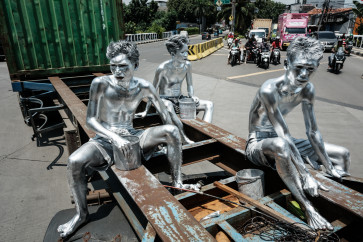Ruminations on Chinese New Year in Indonesia
Every year, around the end of January and early- to mid-February, Chinese people around the world celebrate Chinese New Year
Change text size
Gift Premium Articles
to Anyone

E
very year, around the end of January and early- to mid-February, Chinese people around the world celebrate Chinese New Year. As the Chinese make up approximately one-fifth of the world’s population, the holiday is celebrated by more than a billion people.
In China, extreme weather conditions do not deter millions of Chinese from making their annual trips back to their hometowns from cities such as Beijing and Shanghai.
Overseas Chinese communities also hold the Chinese New Year dinner every year. In tropical countries such as Singapore, where more than 70 percent of the population are Chinese, the lunar New Year decorations are put up as quickly as the dazzling Christmas lights are removed. For smaller nuclear families in the modern city-state, family dinners are usually held at restaurants, which feature traditional yu sheng (raw fish mixed with vegetables and condiments).
In Indonesia, where there is a substantial ethnic Chinese population, the celebration of Chinese New Year is as diverse and complex as the Chinese themselves. In Jakarta, swanky malls are beautifully decorated with bright red lampions, pussy willows and ang pao (red packets) hanging from artfully arranged branches.
In smaller cities such as Singkawang and Pontianak in Kalimantan, preparations for the annual Chinese New Year parade are held for months before the actual parade takes place. During the highly anticipated parade, crowds from all walks of life and ethnicities would line the city roads where barongsai (lion dance) performers and other attractions pass by. Shops belonging to peoples of various ethnicities would invite the barongsai to stop by and perform on their doorsteps. Shop owners believe being visited by the barongsai brings them luck and prosperity. In return, the barongsai would receive an ang pao from the owners.
All the lavish and spectacular decorations and events to welcome the Year of the Rabbit hold special meanings for Chinese people born between 1965 and 1998. This is because members of this particular generation still remember when Chinese New Year was not allowed to be celebrated in public.
Most of them would recall that they could only receive ang pao in their own homes and/or their relatives’ residences.
Some also sought permission from their schools to get a day off work as Chinese New Year was not a public holiday. It was only when president Megawati came into power in 2003 that Chinese New Year was declared a public holiday.
As a member of this generation, I regarded the restrictions as an accepted part of being Chinese in Indonesia. As a child, I never questioned why Chinese characters were not allowed to be displayed in public or why I could not learn Chinese at school.
As an Indonesian, I could only speak and write in Indonesian, alongside my peers. It was only when I moved to Singapore to complete my primary and secondary education that I realized there was something radically different in the ways in which Chinese New Year was celebrated in my country.
While conducting research for my doctoral dissertation on the Chinese of Indonesia and their search for identity, I brought up this observation with Harry Tjan Silalahi, one of the founders of the CSIS (Centre for Strategic and International Studies). Silalahi said that the government’s initial ban on public celebrations of Chinese New Year was intended to deflect attention away from the Chinese, who were targets of mob violence following the 1965 revolution in Indonesia.
This restriction was also part of the Soeharto regime’s closures of Chinese schools, bans on public expressions of Chinese culture and language, and widespread government suspicion regarding the Chinese community role in the PKI (Indonesian Communist Party) uprising of 1965. While there has been a spirit of openness and embrace of Chinese culture between 1998 (which marked the fall of Soeharto’s New Order regime) and the present, Silalahi warned that the Chinese should not be too ostentatious and call unwanted attention to their luxurious lifestyles.
Chinese communities and organizations, numbers of which have mushroomed since 1998, seem to heed Silahahi’s warnings. The biggest of these organizations, the Social Organization of Chinese-Indonesians (PSMTI) and the Chinese-Indonesian Association (INTI), whose members number in the thousands, were originally established to fight all forms of discrimination against the Chinese-Indonesian community in the wake of the horrendous May 1998 riots, where Chinese-Indonesians, once again, became targets of mob violence.
Over the years, however, when discriminatory policies against Chinese language and culture were lifted, these organizations shifted their focus to help fellow Indonesians in times of need — especially in facing natural disasters. Other organizations that were based on common dialect groups, such as the Fu Qing and Hakka associations, have also contributed massive amounts of funds to the building of schools for non-Chinese children. PSMTI and INTI, for example, have also pooled resources to provide disaster aid to victims of earthquakes or the recent Mount Merapi eruptions.
In the weeks preceding Chinese New Year, some Buddhist temples such as the Lodan temple in Ancol, also hold events where food packets are distributed to disadvantaged areas. The predominantly ethnic Chinese patrons of these temples were the chief donators at such events.
As the Chinese of Indonesia welcome the Year of the Rabbit, the younger generation would no longer have any recollection of restrictions on Chinese New Year. They must, however, follow in the footsteps of the older generation to pool their efforts in helping fellow Indonesians and to contribute their achievements in lifting the name of their country.
The writer lectures at the University of Indonesia School of Humanities and Department of Communication. She is also the author of The Chinese of Indonesia and Their Search for Identity:
The Relationship between Collective Memory and the Media.









